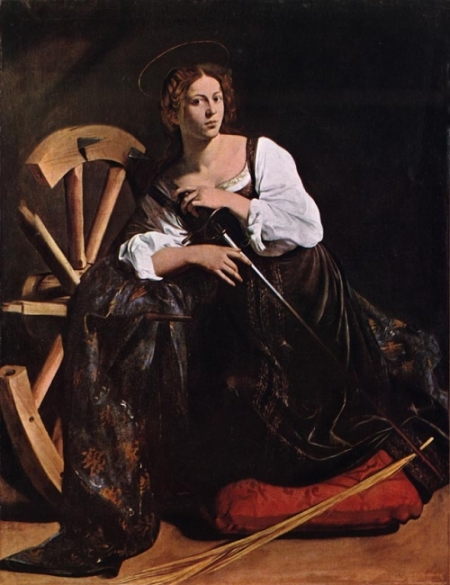Some of my older papers

|
-
(with Sandro Mattarei) Some thin Lie algebras related to
Albert-Frank algebras and algebras of maximal class:
102K dvi file,
126K gzipped ps file
J. Austral. Math. Soc. Ser. A 67 (1999), no. 2, 157-184
-
(with G. Jurman) Quotients of maximal class of thin Lie
algebras. The odd characteristic case, Comm. Algebra 27
(1999), no. 12, 5741-5748:
31K dvi file,
78K gzipped ps file,
Jurman alone has
written a related paper on the case of characteristic two,
Comm. Algebra 27 (1999), no. 12, 5749-5789: 168K dvi file,
153K gzipped ps file
-
Loop Algebras of Zassenhaus Algebras in Characteristic
Three, Israel J. Math. 110 (1999), 61-73.
45K dvi file,
80K gzipped ps file,
-
Thin Groups of Prime-Power Order and Thin Lie Algebras: an
Addendum, Quart. J. Math. Oxford (2) 49 (1998), 445-450:
22K dvi file,
30K gzipped ps file
-
Presenting the graded Lie algebra associated with the Nottingham
group, J. Algebra 198 (1997), 266-289:
75K dvi file,
63K gzipped ps file
-
(with S. Mattarei and M.F. Newman) Graded Lie algebras of maximal
class, Trans. Amer. Math. Soc. 349 (1997),
no. 10, 4021-4051:
152K dvi file,
105K gzipped ps file
|
|
A Picture Gallery
|
|
Why the pictures on my pages?
|
I am no art expert, but I like visiting museums and exhibitions
whenever I have a chance. So I have decided to share my visual
experiences with the visitors to my home page, by posting pictures I
have recently seen, usually face-to-face. Here are the pictures I have used.
I have grown too lazy to write too much about all the
exhibitions and museums
I have seen, so I just add a few pictures here and there, throwing in the odd
comment. Please write me for comments, or if
you are interested in the details.
|
|
In June 2003 I discovered the works of Thomas
Jones, a Welsh
painter who travelled to Italy, writing a diary (whose
printed critical edition
I am going to buy soon). In February 2004 I saw an exhibition
at the National Gallery in London. See also the entry
about him at Tate, and the entry about him in
Giornale Nuovo.
The two main pictures on my home page right now (end of February 2004)
are by him - both were at the NG show. IMHO Thomas Jones was able to
see both the filth and the beauty of Southern Italy (a not-so-easy
feat to this day if you come from the North), and actually could see
that they belonged together - no digital (er, mental) removal of
"lowly" details here.
He must have been in a state of grace when he did
his works in Naples in 1782 - here at the right - they had a wall (!)
for themselves at
the NG show, and that wall stood out.
-
Read about A Wall in Naples in the article by Jonathan
Jones in the Guardian, in particular: Not only is nothing
happening in this picture, but nothing has happened or is going to
happen, except that eventually someone will take in the laundry.
Jonathan Jones is
reminded of Seurat - I was thinking of Cezanne. (See also the comments
on the NG site.)
|
|
-
There is also an
article by
Andrew Graham-Dixon in the Daily Telegraph - he says that [many]
of his sketches have a
snapshot immediacy that seems to predict the cool gaze of
photography, but Jones' talent for composition is surely exquisite -
it takes more than a camera to make a good photograph.
-
There is an article
in the 10 July 2003 issue of The Economist, but it's for
subscribers only - perhaps we may quote: The most famous
[painting], "A Wall
in Naples", has been called "one of the great microcosms of
painting". Though a detailed and beautiful depiction of what Jones
might have seen from his hot upper window, the sketch has a flatness
and all-over composition that would not have looked out of place among
experiments in abstraction 150 years later.
-
Also for subscribers only is the article
by Merlin James from the 13 June 2003 issue of the Times Literary
Supplement, from which I first learned about Jones: What does
it mean to give an accurate, matter-of-fact description of the world,
or part of the world, or something in the world? When I try to
describe objectively what I perceive in front of me, or around me, to
what extent am I giving an account of myself - of my own impressions?
How do I set limits on what I choose to describe, decide what is the
focus of my attention and what is incidental or "background"? [...]
These questions, such as one might expect from a philosophical
treatise, are asked by the tiny, mesmerizing oil sketches of buildings
in Naples, made in 1782 by the Welsh artist Thomas Jones.
- There are many more comments about TJ on the web. We list some in
no particular order: Brian
Micklethwait, PI
mag, UC London, The
Art Newspaper, New
York Review of Books (partly subscribers-only), euromuse
|
|
|
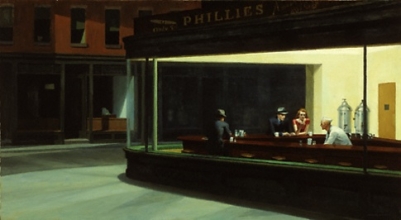
Above: Nighthawks, by Edward Hopper, which I saw at the Art Institute
of Chicago in Spring 2003.
Right: Riposo durante la fuga in Egitto, by Caravaggio, at the
Galleria Doria Pamphili in Rome. The rich nature background is about
unique in his works. The model, as it often happens with Caravaggio
reappears in the same pose as Maria
Maddalena in another picture, also at Galleria Doria Pamphili.
|
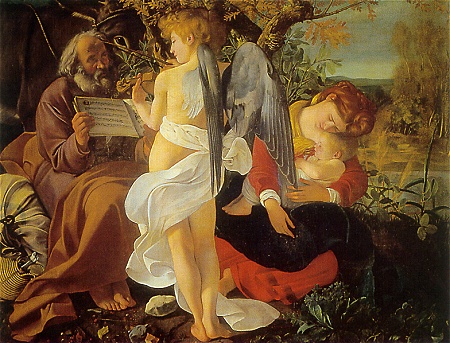
|
|

|
One of the many good Italian films that came out in 2000/01 is Le
fate ignoranti (The ignorant fairies) by Turkish/Italian director
Ferzan
Ozpetek.
In June 2001 I was visiting the Magritte - La storia
centrale exhibit at Complesso del Vittoriano in Rome, and came
upon the picture La feé ignorante (The ignorant fairy)
you see here. I understand Ozpetek indeed took his title from this
picture.
By the way, (some of) the other good Italian movies of the season
were IMVHO, Nanni Moretti's Stanza del figlio, Gabriele
Muccino's L'ultimo bacio and Giulio Manfredonia's Se
fossi in te.
|
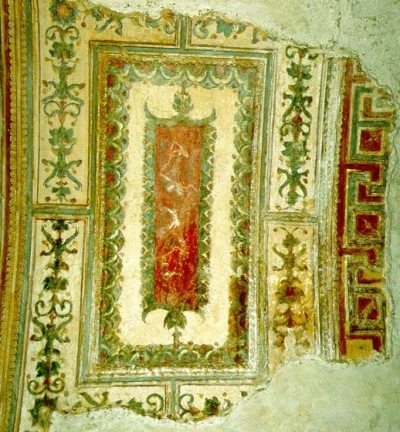
|
The Domus Aurea reopened to the general public in the late years of
the twentieth century. Still, its frescoes and paintings had
influenced artists like Raffaello, who managed to get access to
it. IMHO, here you see one of the roots of our taste for
colours and
decoration.
|
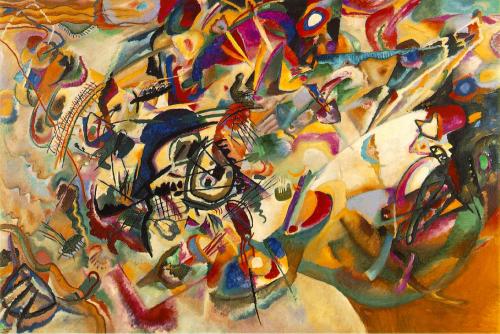
|
I was born in Rome, and I still have family there, so I end up
visiting the city a couple of times a year. I usually take these
chances to visit the current exhibitions. In December 2000 I was to Wassily
Kandinsky - Between Munich and Moscow 1896-1921. An art historian
took us through the pictures. That was very useful. As a kid in
school, I couldn't grasp the point of Art History. It's only when I
got my hands on The
Life and Art of Albrecht Durer by E. Panofsky, that I understood
what was going on. In school I was taught the traditional "idealistic"
viewpoint, in which great stress is given to the feelings an art
object is supposed to evoke in the better part of your inner
self. With me, most of the times no bells were ringing, so what?
Through Panofsky's book I came to realize that one can (simply
put) try and understand what's in a picture, and end up not just
watching it but seeing it. Very often it's only after a careful study
that you see a picture spring to life. The tour of the Kandinsky
exhibition a very competent art historian gave us was just another
example of this phenomenon.
|
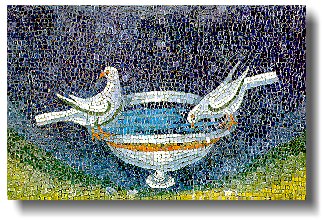
|
When I was a kid, my parents kept taking me and my sisters on
"cultural tours", that for us meant an endless string of dull
churches, palazzi or museums. Then one day we went to Ravenna, and I
was struck by the mosaics. I finally saw if not the light at least the
point.
I have been to Ravenna several times since - in the Spring of 2000 I
went there with my kids, now a parent myself. It was a deep emotion
once more, a new, different one. So I decided to post a picture of one
of the mosaics of Galla Placidia
on my front page. Go to Ravenna yourself, and no doubt you'll see my
point - your own way, that is.
And how did my kids like it, you may ask. Well, they are
third-generation tourists, you know, and they just loved it!
Only later I realized that my recent infatuation with colours, as
displayed on these pages, is presumably related to my latest visit to
Ravenna.
|
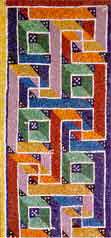
|
|
